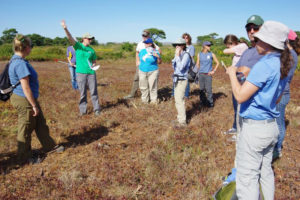Mowing in Existing Grasslands
Mowing can be used to maintain disturbance-adapted sandplain grasslands by manipulating ecological succession. The principal goals of management with mowing are to reduce woody vegetation cover, create conditions that maintain plant and animal species that rely on grassland habitat, and reduce fuels and fire risk.
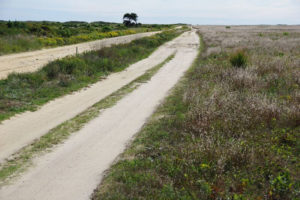
Figure 1. At the Nantucket Land Bank’s Smooth Hummocks Coastal Preserve on Nantucket, an area mowed annually during the growing season on the right side of the road is open grassland while an un-mowed area on the left side is a taller shrubland. Credit: Chris Neill.
Mowing in sandplain grasslands typically aims to promote a diverse assemblage of target grassland species with a high proportion of warm-season grasses and native forbs, a low proportion of cool season grasses and non-native invasive species, while reducing the regrowth of woody shrubs (Fig. 1). Mowing is used in grasslands to top-kill woody vegetation or other undesired vegetation.
The consequences of mowing for maintaining sandplain grasslands depend to a large degree on the structure of the pre-treatment vegetation, mowing timing and frequency, and to a lesser extent on the mechanics of mowing such as the height of cutting. Mowing can be less complicated and more predictable to apply than other management practices such as prescribed fire because its use depends primarily on the availability of equipment and operators rather than favorable weather or trained fire crews. The stage of succession and plant phenology can strongly influence the effectiveness of mowing. The experience of managers employing mowing and results of carefully planned experimental mowing treatments during the last several decades provide information on mowing effects in sandplain grasslands.
In this chapter, we evaluate the effects of mowing in sandplain grasslands compiled from published and unpublished studies and information obtained from interviews with land managers. We focused on the following main questions relevant to sandplain grassland management:
- Does mowing slow woody growth?
- Does mowing maintain or increase grassland associated plant and animal species diversity?
- Under which conditions is mowing more or less effective at reducing woody species cover?
- How can the effectiveness of mowing be improved as a management tool to maintain sandplain grasslands?
We focus on interpreting the main patterns that emerge from examining multiple experiences across multiple sites, with the understanding that responses in any one mowing treatment under particular conditions may differ.
These studies represent only a portion of possible treatments and variables that could be tested. It is challenging to design and execute well-controlled studies to determine the impacts of management techniques on sandplain grasslands when considering the combinations of individualistic species responses, treatments, short and long-term effects, and the number of replicates needed to detect trends in the face of variability (Dunwiddie 1990).
Methods
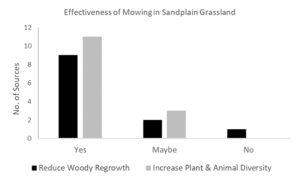
Figure 2. Number of sources that found mowing in sandplain grasslands slowed woody shrub and tree regrowth and increased plant and animal diversity.
We reviewed 75 sources that described or documented results of management actions in sandplain grasslands. Of these, 24 sources contained information on mowing and 18 detailed specific management experiments or case studies. In addition, we interviewed 13 professionals throughout the region about their experiences with mowing in sandplain grassland. Literature sources that tested active management treatments were classified by whether they: (1) reduced regrowth of woody vegetation, and (2) increased biodiversity of plants or animals, or both (Fig. 2).
This review was used to summarize the state of current management understanding of mowing combinations in sandplain grasslands and the effects of mowing on: (1) fuels and soils, (2) vegetation composition, (3) vegetation structure, and (4) fauna in response to seasonality and frequency of mowing. We then suggest ways that the use of mowing could be improved to decrease woody cover, increase graminoid cover and maintain and promote biodiversity in sandplain grasslands.
Results
A very large proportion of the total area of sandplain grasslands on public lands (and likely on private lands) are currently managed primarily by mowing (Oehler 2003). Overall, a large majority of sources found that mowing slowed the regrowth of woody vegetation and increased biodiversity in some manner (Fig. 2). However, no study found that mowing alone was effective at preventing woody species cover from continuing to increase over time. Rather, our review found that most sources suggested the pairing of mowing with other management practices as necessary to control woody regrowth and maintain sandplain grassland biodiversity over the long term.
Logistical and Practical Constraints on the Use of Mowing in Existing Grassland
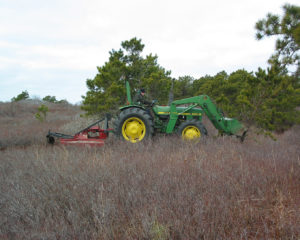
Figure 6. Typical mowing and light brush-cutting equipment used by the Nantucket Conservation Foundation. Photo Credit: Nantucket Conservation Foundation.
Mowing is one of the most practical techniques for managing sandplain grassland because it requires a low amount of training, manpower, and equipment and fewer variables and less complexity associated with its implementation. To be effective, mowing requires short- and long-term strategies. For example, higher frequency mowing might be effective at initially reducing woody growth. In subsequent years, mowing frequency and seasonality can be adjusted to maximize richness of herbaceous species.
Because mowing does not result in mortality to undesirable woody plants in many cases, it requires frequent application and therefore can be time-consuming. Another constraint is that if there is a lapse in management, re-growth can quickly outpace the capacity of the mowing equipment and make follow-up treatments difficult or impossible. Therefore, if a mowing cycle is missed because of time or financial constraints, mowing in subsequent years will be more challenging and costly.
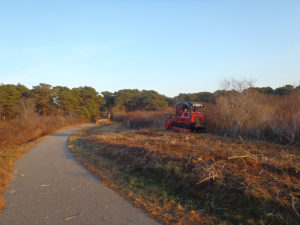
Figure 7. Heavier brush-cutting equipment used by the Nantucket Conservation Foundation to expand grasslands invaded by shrubs and reduce wildfire risk. Photo Credit: Nantucket Conservation Foundation.
The type of mowing equipment and mower settings influence the effects on vegetation (Fig. 6 and 7). The height of the mow deck will determine the cut height of the vegetation. The time of year at which mowing commences will determine how seed set and maturation of particular species will commence and be impacted. In addition, very low mower blades have a higher propensity to disturb the organic layer of the soil (D. Crary, Interview; Greller et al. 2000) and thereby might increase risk of invasive species establishment. It is important to be able to adjust the height of the mower deck to target different plants depending on the site conditions and the desired grassland management goals (C. Politan, Interview).
Access and site conditions, such the presence of rocks, larger trees, tree stumps, fence posts or waterways create physical barriers that can make mowing more challenging because it is difficult to operate a tractor safely in those conditions. However, compared with prescribed fire, mowing is logistically easier for several reasons. There are fewer constraints on mowing based on time of year and fewer regulatory restrictions. In coastal regions, mowing is not as influenced by the summer tourist season and therefore can be more easily conducted during summer when disturbance to woody shrub growth is more effective. Because the timing of mowing is flexible, it may be easier to align with timing of funding available for management, and mowing is not spatially limited by proximity to houses. In addition, mowing can be much less expensive than prescribed fire depending on the duration and the desired impact (K. Fauteux, Interview). Therefore, mowing is often used in properties where burning cannot be conducted because of the location, the time of year, and lack of funding (C. Buelow, Interview). Risk management is also an important consideration with any management practice. Compared to fire, mowing is a much less risky alternative (K. Beattie, Interview).
While mowing can simulate many effects of burning, the differing mechanisms (maceration vs. incineration) have different long-term effects on grassland communities. Management that depends solely on mowing may create high amounts of litter and thereby potentially alter soil characteristics and result in a more uniform treatment. This may not create mineral soil niches, reduce seed pests, create other conditions that favor target grassland plants, or create conditions for species that require bare patches for travel corridors and nesting (Dunwiddie, reported in Revised Management for Katama 2000).
Although mowing during particular times of stress (e.g., droughts or outbreaks of herbivorous insects) could increase its effects and reduce the frequency of management required to obtain similar vegetation responses, being able to take advantage of these events in particular places will likely be challenging.
Summary and Pathways to More Effective Management
The effects of frequency and seasonality of mowing on vegetation structure in sandplain grasslands have been studied in field management experiments. Summer mowing most effectively reduced woody vegetation cover and increased forbs and graminoids compared with spring and fall mowing. Mowing has low logistical constraints compared with fire, but it also creates higher amounts of litter that may reduce diversity of target plants and animals. These factors suggest that combinations of summer mowing and occasional prescribed fire could potentially be effective. This approach may take advantage of the ease of use of mowing in most years while maintaining the benefits of fire applied less frequently. Further, mowing first can reduce the complexity and risk of follow-up fire management, perhaps making fire more feasible or likely to be implemented (K. Beattie, Interview).
This review identified several major ways to improve understanding and potential benefits of the use of mowing for sandplain grassland management:
(1) Test more combinations of mowing with fire or vegetation removal of woody vegetation. These tests should be designed and monitored as field experiments. Combinations could be tested as sub-plots within large areas that are currently being managed by mowing. Areas of fire or vegetation removal could be applied as plots within the larger mowed area.
(2) Improve understanding of how infrequent or rare plants respond to different mowing combinations. There is currently almost no information on how these species respond to mowing and the effects of mowing seasonality and frequency.
(3) Determine how mowing affects the mortality and population dynamics of insects, birds, mammals and reptiles in sandplain grassland. These effects may be particularly important for less mobile reptiles and insects that might be killed by mowing.
References
Atwood, J., Collins, J., Kidd, L., Servison, M., & Walsh, J. 2017. Best management practices for nesting grassland birds. Mass Audubon, Lincoln, MA. 10 pp.
Clarke, G.L., & Patterson III, W.A. 2007. The distribution of disturbance-dependent rare plants in a coastal Massachusetts sandplain: Implications for conservation and management. Biological Conservation 136: 4–16.
Dunwiddie, P.W. 1998. Ecological management of sandplain grasslands and coastal heathlands in southeastern Massachusetts. In Pruden, T.L. & Brennan, L.A. (eds.), Tall Timbers Fire Ecology Conference Proceedings, N. 20, pp. 83–93. Island Press, Tall Timbers Research Station, Tallahassee, FL.
Dunwiddie, P.W., & Caljouw, C. 1990. Prescribed burning and mowing of coastal healthlands and grasslands in Massachusetts. In Mitchell, R.S., Sheviak, C.J., & Leopold, D.J. (eds.), Proceedings of the 15th Annual Natural Areas Conference, New York State Museum Bulletin 471, pp. 271–275.
Dunwiddie, P.W., Patterson III, W.A., & Zaremba, R.E. 1995. Evaluating changes in vegetation from permanent plots: An example from sandplain grasslands in Massachusetts. In Herman, T.B., Bondrup-Nielsen, S., Martin Willison, J.H., & Munro, N.W.P. (eds.), Ecosystem Monitoring and Protected Areas, pp. 245–250. Science and Management of Protected Areas Association, Science and Management of Protected Areas Association, Wolfville, Nova Scotia.
Farnsworth, E.J. 2007. Plant life history traits of rare versus frequent plant taxa of sandplains: Implications for research and management trials. Biological Conservation 136: 44–52.
Greller, A., Wijesundara, D.S.., & Tanacredi, J.T. 2000. Phytosociological analysis of restored and managed grassland habitat within an urban national park. Urban Ecosystems 4: 293–319.
Management Plan for the Katama Plains Conservation Area. 2000. Edgartown, MA. Unpublished report to The Nature Conservancy.
Martin, K.M. 2008. Disturbance-based management and plant species change in Massachusetts sandplain heathlands over the past two decades. M.S. Thesis, unpublished. University of Central Florida, Orlando, FL.
Matlack, G.R. 1997. Resource allocation among clonal shoots of the fire-tolerant shrub Gaylussacia baccata. Oikos 80: 509–518.
Mowing Advisory Guidelines in Rare Turtle Habitat: Pastures, Successional fields, and Hayfields. 2009. Report to The Natural Heritage and Endangered Species Program, Westborough, MA.
Oehler, J.D. 2003. State efforts to promote early-successional habitats on public and private lands in the northeastern United States. Forest Ecology and Management 185: 169–177.
Raleigh, L., Capece, J., & Berry, A. 2003. Sand barrens habitat management: A toolbox for managers. Vineyard Haven, MA. Unpublished report, The Trustees of Reservations, Boston, MA.
Rudnicky, J.L., Patterson III, W.A., & Cook, R.P. 1997. Experimental use of prescribed fire for managing grassland bird habitat at Floyd Bennett Field, Brooklyn, New York. In Vickery, P.D. & Dunwiddie, P.W. (eds.), Grasslands of northeastern North America: ecology and conservation of native and agricultural landscapes, pp. 99–118. Massachusetts Audubon Society, Massachusetts Audubon Society, N.Y. Field Office, 1736 Western Ave. Albany NY.
Zuckerberg, B., & Vickery, P.D. 2006. Effects of mowing and burning on shrubland and grassland birds on Nantucket Island, Massachusetts. The Wilson Journal of Ornithology 118: 353–363.
Other Sources
Beattie, Karen. Interviewed by Lena Champlin. Unknown date.
Buelow, Chris. Interviewed by Lena Champlin. November 20, 2016.
Crary, David. Interviewed by Lena Champlin. December 6, 2016.
Fauteux, Kristen. Interviewed by Lena Champlin. December 12, 2016.
Freeman, Rachael. Presentation at Smooth Hummocks Nantucket 22, 2017.
Goldstein, Paul. Interviewed by Lena Champlin. December 11, 2016.
Jones, Mike. Interviewed by Lena Champlin. November 20, 2016.
Mello, Mark. Interviewed by Lena Champlin. December 10, 2016.
Neill, Chris. Interviewed by Lena Champlin. November 2, 2016.
Polatin, Chris. Interviewed by Lena Champlin. January 9, 2017.
Simmons, Tim. Interviewed by Lena Champlin. December 14, 2016.
Vitz, Drew. Interviewed by Lena Champlin. November 20, 2016.
Weigand, Polly. Interviewed by Lena Champlin. November 16, 2016.



